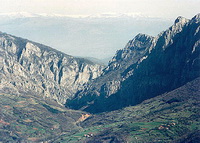{tab=highlights}
About 30 km far from the town of Pirot, you can see one of the most beautiful landscapes in Serbia - the canyon of river Jerma (pronounced "Yerma"). With its steep rocky walls, at some parts so close that there's hardly enough space for the river Jerma itself and the narrow road following it, it reminds of the movies about the Wild West. The barren rocky hill Asenovo Kale, 1032 m high, is a famouse grey eagles nesting place. There is also the Poganovo monastery, built in the early XV century, as well as the monastery Sukovo, originating from the same period, with a misterious fresco of St. Christiphore with a donkey head. Numerous caves and the Vetreno lake add to the beauty of this area.
{tab=history}
Poganovo monastery was built by a nobleman by the name of Konstantin Dragas and his wife Jelena. He was one of the squires of the despot Stefan Lazarevic. Even though it cannot be precisely said when the church was built, it is believed that it was between 1413 and 1423, in a short period when this area was liberated from the Turks.
Frescoes of the monastery church were painted much later, as witnessed by the inscription above the main gate, that says that this temple of St. John was fresco-painted in October of 1499.
Till the WWI, a famous double icon, one of the most beautiful icons dating from the XV century, donated to the monastery by the wife of the last Byzantine emperor Constantine XI Paleologus, was kept in this monastery. This icon is now at the museum of icons in Sofia, as well as the iconostasis from the XVII century also taken by the Bulgarians during the war.
Roman swimming pool and other archeological remainings tell us that Zvonacka Banja (Zvonacka Spa) was known in ancient times and in the days of medieval Serbia. In 1894, the locals discovered here a hot mineral water spring while searching for a hidden treasure. This discovery remained unnoticed till the 1912, when a Bulgarian teacher Dilberov got interested in hot water that effluxed under the ash tree. Unfortunately as the war broke out, he didn't manage to do much. In 1923, a narrow gauge railway was built through the ravine of Jerma, for the exploitation of cole. Gose Nikolov from Caribrod built then two villas here and a female and male bath. In 1987, a narrow asphalt road was built to this place.
The monastery Sukovo was built over the remainings of a smaller church. Many miracles are related to the discovery of this ruins. The establishers of the today's temple, built in 1857, were a priest Jovan Madic and a monk Vincijamin. Bulgarians attacked the monastery in 1885, 1913 and 1914, and it was also robbed by the Cherkezs in 1886. The inner walls were painted by Vasilije Pop-Hristov from Samokovo.
{tab=getting there}
From the road Pirot - Dimitrovgrad, take a turn by the village Sukovo, where the monastery with the same name is located. After the monastery, down a narrow asphalt road you will pass through the canyon of Jerma. Poganovo monastery is situated roughly in the middle of the canyon, and Zvonacka Banja (spa) some 6 km after the canyon.
Pirot can be reached by bus from Belgrade. Buses leave Belgrade every day at 10:00 am, 11:15 am, 2:15 pm, 5:30 pm and 7:00 pm.
Two daily buses leave from Pirot to Zvonacka Banja: 7:50 am via Babušnica, and 2:00 pm via Sukovo. The ride takes about an hour, and the ticket costs 1.5 euros via Babusnica, or 2 euros via Sukovo. The bus that goes via Sukovo passes through the whole canyon of Jerma.
Village Sukovo is at the very beginning of the canyon. The canyon is 15 kilometers long which is roughly a three-hour walk.
Bus station Pirot, Vojvode Misica bb, phone: +381 (0)10 / 332 - 548
{tab=things to see}
The canyon of Jerma river is 15 km long, with amazing Wild West-like sites all around. Barren, rocky cliffs, hundreds of meters high, enclose from both sides the river, by which a narrow asphalt road goes, all the way from Sukovo to Zvonacka Banja.
Halfway through the canyon there is a monastery Poganovo, built in XV century. The monastery church is dedicated to St. John the Baptist. With its architecture, the church belongs to Moravian school of architecture, but it doesn't have typical ornaments on the facade. The basis of the church is a cross with three half-circled apsides.
The monastery was built by Konstantin Dragas and his wife Jelena, as can be read on the western wall, just above the porch, on three stone medallions, which have the names of the founders and of a saint to whom the church is dedicated. On the southern window column, the name "Jovan Teolog" can be made out, written in Greek alphabet. On the norhern side, just opposite of this pillar, a column with the engraved name "Constantin" can be seen.
The frescoes are a work of the masters who worked in the period of sultana Mara, who had a great influence on the Christians in the Ottoman empire. She was Serbian, from the Brankovic noble family, and she was the mother of sultan Mohammad II the Conqueror. The style of the frescoes shows a strong influence of the Western, especially Italian art of the late middle ages, which is visible in the encounter of the Orthodox spirituality with a post-gothic naturalism. Rough drawing and emphasized reality of the forms follow, nevertheless, strict Orthodox idea.
In the vicinity of Zvonacka banja, ruins of the medieval fortress Asenovo Kale are located. The ruins are right next to the clif with the same name, 1032 meters high, a nesting spot of the gray eagles. Not far away there is also a cave, Vetrena Dupka, about 4 km long, as well as the Sukovo monastery.
{/tabs}

